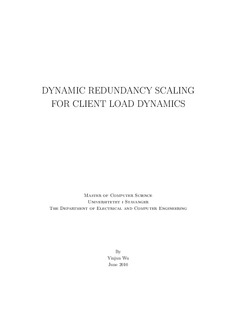| dc.contributor.author | Wu, Yinjun | |
| dc.date.accessioned | 2010-09-22T14:56:50Z | |
| dc.date.available | 2010-09-22T14:56:50Z | |
| dc.date.issued | 2010 | |
| dc.identifier.uri | http://hdl.handle.net/11250/181707 | |
| dc.description | Master's thesis in Computer science | en_US |
| dc.description.abstract | This paper presents the mechanism and implementation of dynamically redun-
dancy scaling for client load dynamics. The scaling is about the control of max-
imum and minimum counter of replicas which provide identical service in a dis-
tributed computer networks. This mechanism is managed under a Distributed Au-
tonomous Replication Management (DARM) framework which is of autonomous
fault treatment supporting and builds upon Spread group communication system.
DARM, like the other existing fault tolerance frameworks, has good solution on
fault detecting and toleration aspects; apart from that, DARM is set to always keep
recovering a faulty service in a active manner and the recovery is done by generating
new replica of the same service in another machine which locates within the same
network. The objective of DARM, which is focus more on the improvement of
dependability of the system, makes DARM novel among all similar frameworks.
The objective of this dynamical redundancy scaling mechanism built on DARM
is to actively and efficiently control the maximum and minimum counter of the
replicas in an appropriate state. The maximum and minimum counter will di-
rectly effect on the identical-service-providing replicas within a distributed net-
work. When a host is observed with higher CPU load value than a preset thresh-
old, new replicas will be automatically created; similarly, when a host is viewed
with lower CPU load, it will be considered to kill if it has not achieved the least
replica number that required among the whole network.
This scheme allows system vary the replicas number according to the situation
of the service loading all over the network: A new replica can be added to share the
burden of whole; an existing replica can be removed to avoid unnecessary resource
consuming. The advantages of this schema are: (i) comparing with static control,
a dynamic one is more practice-oriented; it has better
exibility for the realistic
service loading in a network; (ii) possibility of host crashed due to high loading
on top of it is reduced, the principle behind this mechanism is to always balance
the existing loading over all active hosts. The approach has been evaluated as an efficient mechanism support to the current DARM framework.
A C implementation of this dynamic control mechanism has been accomplished
and introduced in this paper, as well as its testing evaluation. The performance is
positive and effective. | en_US |
| dc.language.iso | eng | en_US |
| dc.publisher | University of Stavanger, Norway | en_US |
| dc.relation.ispartofseries | Masteroppgave/UIS-TN-IDE/2010; | |
| dc.subject | informasjonsteknologi | en_US |
| dc.subject | datateknikk | en_US |
| dc.title | Dynamic redundancy scaling for client load dynamics | en_US |
| dc.type | Master thesis | en_US |
| dc.subject.nsi | VDP::Technology: 500::Information and communication technology: 550::Computer technology: 551 | en_US |
| dc.source.pagenumber | 49 p. | en_US |
